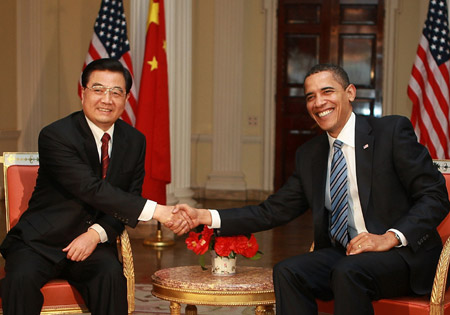Overseas Chinese in the United States are composed of three different groups, American born, naturalized, and permanent residents. As an ethnic group, overseas Chinese have lived and worked in the United States for more than two centuries. They have sacrificed and contributed to the building of the nation and have served as a bridge between the United States and China.
National and cultural identity has always been a challenge to immigrants in the United States. Chinese Americans, in particular, are conscious of both their Chinese cultural heritage and their American national identity. According to the 2000 U.S. census, there are 2,734,841 people of Chinese ancestry in the total U.S. population of 281.4 million. Overseas Chinese came from China and different parts of the world, such as Singapore, Cuba, Peru, and Canada.
Overseas Chinese have brought tremendous economic contributions. Early Chinese immigrants to the United States were generally from the Pearl River delta areas of Taishan, Kaipin, Xinhuei, Heshan, and Enping in southern China. Some of them came through Canada and South America. Although most of them were laborers who worked as farmers and industrial workers, there were also doctors, merchants, artisans, teachers, and students. Early Chinese immigrants also worked in mines during the gold rush era in the 1840s. In the 1860s, they contributed greatly to the construction of the transcontinental railroad that linked the East to the West and became vital in the economic development of the United States. Small businesses such as Chinese laundries and restaurants provided services for the convenience of people's daily life. However, Chinese settlement and adaptation have not had smooth sailing all along.
As early as the late 19th century, Chinese in the United States brought cases to the Supreme Court to protest their unequal treatment because of their race and ethnicity. Cultural ignorance and racial prejudice in conjunction with institutionalized anti-Chinese rhetoric made it almost impossible for the Chinese to come to the United States and to stay. On May 6, 1882, Congress passed the Chinese Exclusion Act, which legally prohibited Chinese from freely entering the United States. The Chinese Exclusion Act was the first national legislation that banned immigrants on an ethnic basis. For decades after the 1882 Chinese Exclusion Act, more laws and regulations were imposed. The quota system of the 1924 immigration law declared Chinese already residing in the United States ineligible for citizenship. Local laws that prohibited Chinese from buying land and owning property were also enacted.
Despite the social hostility and political antagonism, overseas Chinese pursued racial equality through judicial processes. More than 9,200 Chinese immigrants filed civil suits against the exclusion laws between 1882 and 1905. They petitioned American authorities for their constitutional right to live and to work in the United States. They also rallied and participated in mass demonstrations to express their opposition to restrictive legislation publicly.
Engagement rather than disengagement became the strategy of overseas Chinese to integrate themselves into mainstream American life as citizens. While Chinese were forced into isolation as a consequence of exclusion laws, their conscious decisions to participate in political, economic, and social events rose, particularly during the Great Depression, which also helped them form a new dual identity as Chinese Americans. They formed their own labor organizations and took part in American labor-union movements at large to protect their economic interests. Their involvement in local and national political campaigns demonstrated their insistence on political democracy and their intention to be included in the system.
World War II provided a tremendous impetus for overseas Chinese to realize their goals. Even before the Pearl Harbor attack, Chinese Americans joined the American military forces to support the Anti-Japanese War in China. In addition, they donated millions of dollars for civilian relief. More Chinese Americans joined the army when Japan attacked the United States. Many laid down their lives. Their contributions to the United States and to the war effort were recognized by society and eventually led to the repeal of the Chinese exclusion laws in 1943.
Cultural diversity has been another front where overseas Chinese brought about many changes. The Chinese maintained their language and culture and contributed to the mosaic of American cultures. After-school programs such as Chinese-language learning, Chinese painting, and calligraphy, as well as Chinese martial arts, are popular and are shared by all ethnic groups.
The new immigration laws of the 1960s opened the door to better immigration opportunities. Intellectuals, scientists, technical personnel, and businessmen composed a large portion of the immigrants. Good education and skills make it easier for them to integrate into American society. Like their predecessors, the younger generation is hardworking and proachieving. Many overseas Chinese have become leaders in politics, science, architecture, sports, education, and business. Gary Locke, for example, who was born in Seattle, Washington, in 1950, became the first Chinese American state governor (in Washington) in 1996. Elaine L. Chao was appointed as secretary of labor by President George W. Bush, thus becoming the first Chinese American woman to join the U.S. cabinet. Architect I. M. Pei, famous for his sharp and geometric designs, received both the American Institute of Architects Gold Medal in 1979 and the Pritzker Architecture Prize in 1983. David Ho was named Time magazine's man of the year in 1996 for his discovery of the replication of HIV in the human body and his "cocktail" treatment of AIDS.
Through centuries of struggle, overseas Chinese as a whole have risen from lower levels of American society to the middle class. From being restaurant owners and laundry workers, they are stepping into leadership in virtually all areas of modern society.

No hay comentarios:
Publicar un comentario